Career burnout and its effect on health
Last updated on: December 28, 2021
If you are being cynical about your work, feeling listlessness, or failing to perform your work — you might be dealing with a silent enemy called career burnout. At first, people who burn out are chronically fatigued, have trouble falling asleep, lose their appetite, and simply cannot focus on anything. So, in an effort to work more and better, they actually ruin their ability to work at all.
In this blog post, we’re going to define career burnout, introduce some research and statistics on burnout, talk about its symptoms, causes, and preventive measures for overcoming this harmful condition.
Table of Contents
What is career burnout?
Burnout is not an official medical term but a consequence of dealing with prolonged stress and being overworked.
There is also no official definition of burnout — some most common symptoms typical for burnout include mental (or physical) exhaustion, reduced performance, listlessness, and cynicism, among others.
Most commonly, it’s work-related, and this type of burnout is referred to as — career burnout.
However, burnout can be associated with other aspects of life such as caring for ill or old family members, children with special needs, or even romantic relationships.
Professional burnout is common among nurses and other healthcare workers.
According to a study on consequences of early-career nurse burnout conducted in 2020, out of 2,474 nurses, 12.3% reported high levels of burnout symptoms during the early stages of their careers.
During the first three years of their career, they came across the most detrimental effects of burnout: cognitive problems and insomnia.
As of May 2019, burnout has officially been recognized by the World Health Organization and the International Classification of Diseases (ICD-11) as an “occupational phenomenon” — with the possibility of it being proclaimed a proper disease in the future. There is currently further research looking to provide additional information about burnout and distinguish it from other conditions.

Worst real burnout cases
41% of people who clock in 50+ hours per week say their companies don’t address burnout, and 36% don’t know whether employee wellness programs are even an option.
But, there are ways you can help yourself, once you get to know what burnout really means.
To acknowledge the fact that burnout is “out there”, we visited Reddit and discovered hundreds of burnout-related topics (the truth is — we didn’t have to search far).
Therefore, according to several discussions on Reddit, real people have suffered severe cases of burnout, which proves burnout is not to be taken lightly: violent daydreams, mental breakdowns, and sudden resignations seem to be only half of the story.
Let’s take a look at some of the most detrimental cases of burnout from personal experiences:
Daydreams about accidents
Daydreaming about getting into minor car accidents to rest at a hospital seems to be quite common.
Imagining how it would be to fling oneself in front of a moving vehicle is another popular fantasy.
One of the more severe cases is daydreaming about the elevator cables snapping while you’re riding said elevator to a high floor.
Resignations
Some other burnout victims have reportedly slammed their laptops in their client’s faces and simply left meetings, only to resign the day after.
Others have stayed up late to finish a project, which prompted them to send in their resignations in the dead of the night.
Some have left their work for lunch never to return or call again.
Mental collapses
One man had to have his colleague wrap up his files at work — he was unable to do so himself because he had previously checked-in in a mental hospital.
Another serious case of a mental breakdown caused by burnout was a man who started bedwetting due to stress.
Substance abuse
A great number of the people from Reddit reported using various substances — from alcohol, pain killers, and cigarettes, to marijuana and psychedelic drugs in the worst-case scenarios.
One of the main reasons they abused substances was finding solace — since substances gave them false energy to carry on with their jobs and unwind at the end of the day.
Suicides
The most severe case seems to be connected with suicide — some just seriously considered crashing their cars, and others have jumped off roofs to their deaths.
So, burnout can cause people to do and think about terrible things — but which are the burnout signs that one can recognize to be able to respond promptly?
Career burnout symptoms
To distinguish burnout from other disorders, take a look at the most common burnout symptoms divided into two groups:
- Physical burnout symptoms
- Psychological burnout symptoms
1. Physical burnout symptoms
Physical symptoms such as chest pain, shortness of breath, and dizziness are all signs that burnout has progressed. If it comes to them, you need to seek professional medical health.
Burnout will also cause your immune system to weaken, so you may fall prey to various infections, colds, or flues. If you’re an overachiever suffering from a mysterious cold for two long months, chances are burnout is the hidden culprit.
Apart from having damaging effects on the immune system, burnout is also associated with sleep disturbances, increased risk of cardiovascular diseases (CVD), and even male infertility — according to Research Companion to Organizational Health Psychology.
2. Psychological burnout symptoms
Your psyche takes a hit as well — at first, you feel tense, irritable, and prone to outbursts of anger.
Then, cynicism and detachment also kick in at some point, so you start to:
- Feel pessimistic about your future.
- Feel detached from others and your environment.
- Physically and emotionally isolate yourself from others.
- Lose enjoyment in everything you might have liked about your job and work-related activities.
As time goes by, you start to feel anxious, lethargic, apathetic, which in the end may lead to depression.
According to the ICD-11 World Health Organization definition, there are three main signs of burnout in the workplace — if you feel all three of these symptoms, you are likely suffering from burnout:
- Feeling a depletion of energy and exhaustion.
- An increase in mental distance from the job, as well as feeling negative and cynical about one’s job.
- Poorer performance at work.
These are just some burnout symptoms — it may manifest differently in different people. So, for more information, check out this scientific overview on burnout, updated with the latest findings every two to three years.
Research and statistics on burnout
In recent years, the interest in burnout has increased — the ever-increasing number of scientific articles, as well as the number of data collected on the subject, prove this.
Here are some of the more crucial statistics on burnout and stress taken from Statista and several other websites.
Are people familiar with burnout?
When you know what burnout is, your chances to prevent and address it increase. But, how many people are aware of this term, and what it actually means?
Let’s take a look at the chart below for more insight.

As evident, the share of adults who have heard of burnout is substantial — 79% are familiar with the term and its definition, which is great news — although an effort should be made to fully educate the remaining 21%.
How many people have had contact with burnout?
Though people know what burnout is, they may not be capable of recognizing it when it happens to others — or themselves.
According to more research from Statista, age has an influence on whether you, or somebody else, has had contact with burnout, or not.

It seems that the older you are, the less you’re aware of burnout — the 60+ group holds the least share of people who have had experience with burnout or know someone who has suffered it.
In total, only about 26% from the 60+ group have experienced burnout, or know someone else who has — which is a stark difference to the 65% share of those aged 18–29 with the same experiences.
The share of people unaware of burnout cases around them is substantial — this may indicate that a lot of people who are experiencing burnout are keeping it a secret. Again, those aged 18–29 are most likely to have come into any contact with burnout, as opposed to the 78% of people older than 60.
Burnout by country
Not all countries have the same number of people who’ve experienced or felt on the verge of burnout. Furthermore, the percentage of the most affected countries keeps rising each year — the pandemic didn’t do any good either.
These are data from the USA and several European countries most affected by burnout, according to the latest research from 2021:
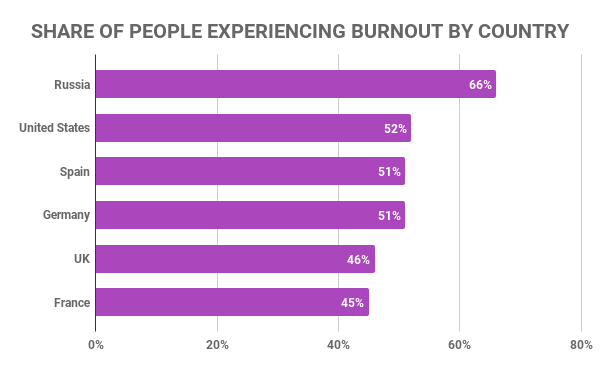
Russia is leading here (66%), while more than half of the people from the US (52%) have experienced burnout, too. However, the people from the Western European countries, with around 45% to 51% share, aren’t doing much better either.
Interestingly, the UK numbers dropped from 57% in 2019 to 46% in 2021.
Opinions on burnout
People who have knowledge of burnout, or experience with it, have varied opinions about it:
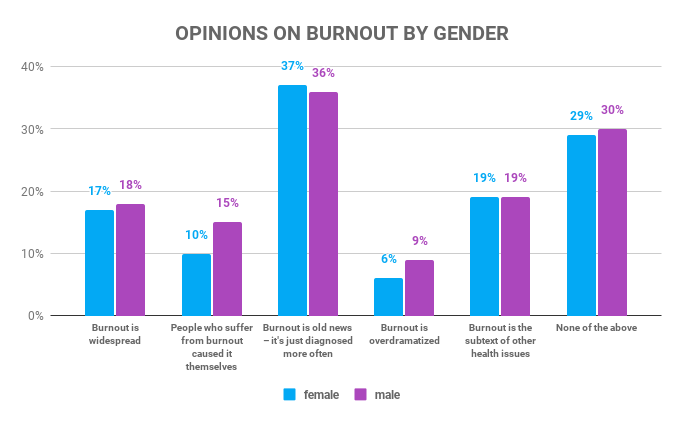
The positive data is that a lot of people (17% females and 18% males) are aware that burnout is widespread, and the majority (37% females and 36% males) believe it’s not a new condition — it’s rather being diagnosed and treated more often.
Only 6% of females and 9% of males believe it to be overdramatized — which means most people take the conditions seriously, as they should.
Reactions on burnout
The environment has varied responses when someone close to them experiences burnout:
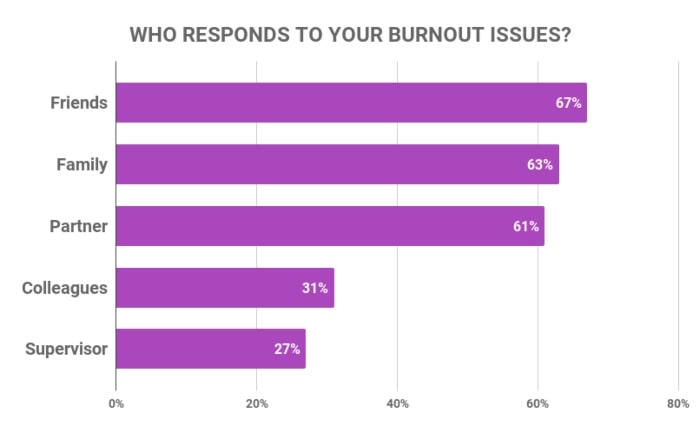
As expected, your friends (67%) and family (63%) are the most understanding when you experience burnout.
The reactions in your company aren’t as timely — only 31% of colleagues and 27% of supervisors react to burnout.
How do companies deal with burnout?
Apart from their poor reaction scores, companies don’t seem to be putting enough effort in dealing or preventing burnout among their employees.
This is what the statistics show:
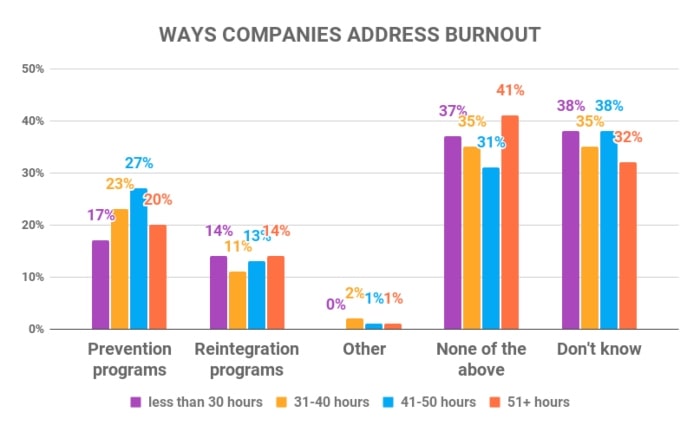
Prevention programs that include stress management and preventive healthcare are the most common types of programs available — although the share of employees who have such programs available is small, with the highest share being 27% for people who clock in between 41–50 hours.
Reintegration programs that include coaching and other training meant to help people who’ve already experienced burnout are even rarer — the highest share is 14% for people who work less than 30 or more than 50 hours.
It also seems that the bigger the norm for employee hours, the lesser the chance that the company will address burnout — 41% of people who clock in 50+ hours state that their company doesn’t offer a burnout program at all, and 32% are unsure of it.
Stress as the leading cause of career burnout
An increasing number of people today are feeling stressed over work. They perform massive amounts of work on a weekly basis, all in an effort to stay ahead of the competition — and looking up to famous entrepreneurs who claim to successfully clock in 100+ hours every week isn’t helping.
Since stress at work is the leading cause of career burnout, we want to include some statistics regarding stress, its causes, most stressful jobs, and much more in the section below.
Most stressful jobs of 2021
Since things have changed since 2019, according to U.S. News & World Report, here is a list of top 10 most stressful jobs in 2021 — together with their median salary:
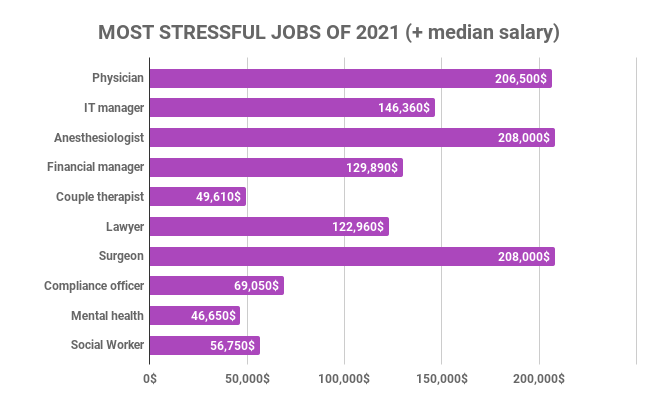
Physicians were on the frontline to fight the deadly virus and, therefore, ended up being the most stressful occupation in 2021.
IT managers take the unenviable second position. Some may think their job is stress-free, but the truth is far from that. The majority of the IT specialists need to be reachable 24/7 and need to keep up with the ever-evolving technology.
Together with lawyers, financial managers, and compliance officers — other health workers are predominant on the list with good reason.
Least stressful jobs of 2021
From the same source, we present you the least stressful jobs of 2021:

If you ever get tired of working in an office and sitting for hours, consider mowing lawns and enjoying outdoor time as a landscaper or groundskeeper.
If you don’t mind sitting long hours and designing websites, web development might be a good option for you (and the pay is not so bad itself either).
Other low-stress occupations include therapists, dental hygienists, and cartographers.
Adults affected by stress from 2012 to 2017
The 2012–2017 statistics from Statista show that about half of all American adults have felt stressed during this time period.
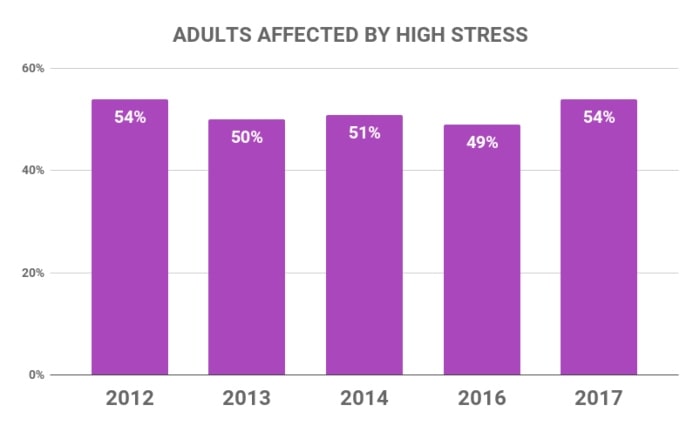
Main causes of stress from 2017
According to a survey from 2017, the sources of stress reported by employees in North America vary, ranging from strenuous workload to a lack of job security:
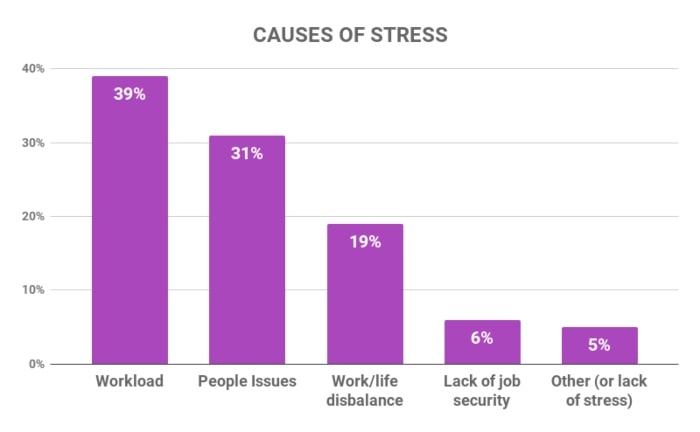
The workload takes the highest share of the blame for stress (39%), although people issues are a close second, with a share of 31%.
Main causes of stress at work (post COVID-19)
Much has changed during the past couple of years.
The American Psychological Association (APA) has devastating news — about 8 in 10 adults (78%) reported COVID 19 to be the major stressor in 2020.
Apart from having adverse effects on personal relationships, mental and physical health, the pandemic contributed to employees’ poor financial situation, cutting employees’ working hours, losing jobs, lowering employees’ productivity, and unhealthy work/life balance.
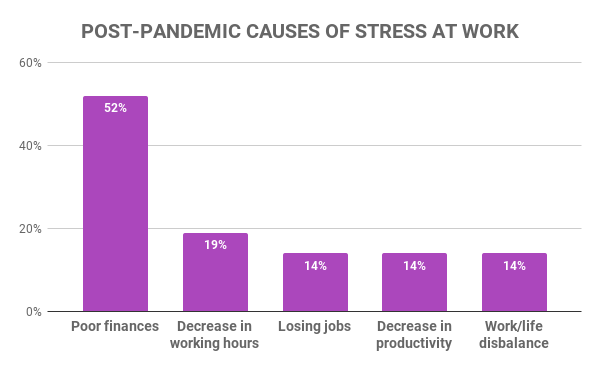
Most stressful jobs
According to Statista, here are the 10 most stressful jobs in the US of 2019 together with their stress scores (the higher the score the more stressed a person feels while performing their job):
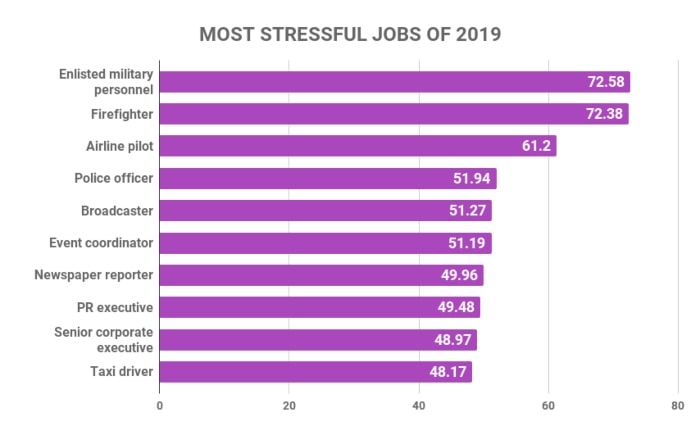
Enlisted military personnel (total stress score 72.58) and firefighters (total stress score 72.38) expectedly take the lead — the list mostly alternates between professionals who risk their lives and those who spend most of their working hours in the public eye.
Considering that they’re under a lot of pressure, these professionals are often in danger of burning out.
Least stressful jobs
However, not all professionals have it that bad — here are the 10 least stressful jobs of 2019 with their corresponding stress scores:

Diagnostic medical sonographers (total stress score 5.07) and compliance officers (total stress score 5.76) seem to have it easiest when it comes to stress — the list also includes hairstylists (total stress score 6.72) and jewelers (total stress score 9), while massage therapists (total stress score 10.39) round up the list.
How do people affected with burnout deal with it?
People’s opinions on how they should address burnout differs, but we’ve prepared a visual representation of the most common strategies that people use to avoid burnout when action is required:

It was found that 63% of US adults believe that less work pressure is the best strategy to help avoid burnout when experiencing symptoms that have already been stated above. Having a hobby is a close second, with a share of 58%.
This is in line with the statistics that 52% of adults in the U.S. would turn to their family and friends in case of burnout:
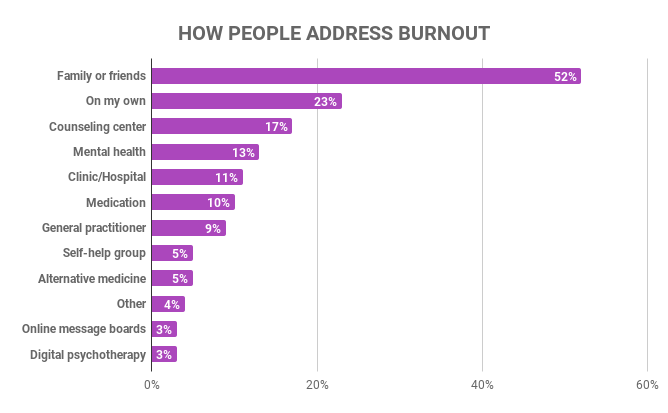
In total, about 55% would also turn to a professional to treat and advise them, which is the right way to approach the matter.
The alarming statistic, however, is the share of people who’d try to get through their burnout alone (23%), and the share that would immediately turn to medication (10%).
Causes of burnout
Many factors can cause burnout — most reasons stem from some sort of pressure and feeling stressed out at work, usually caused by a practice they consider uncomfortable.
We’ve rounded up some of the most common causes of burnout:
Lack of control
Feeling powerless about your position at work is one of the biggest factors.
Perhaps you have little control of what you should do — your schedule, assignments, and priorities are determined by someone else in a way that doesn’t really suit you.
Or, perhaps you don’t know what is expected of you — if you don’t know what your supervisors expect, or if you’re unaware of the level of authority you possess, you’re hardly going to feel comfortable at work, which will cause you stress.
Boredom or chaos at work
Another trigger for burnout is the everyday dynamics in the workplace.
Perhaps you’ve taken a job out of necessity, one that doesn’t fit your skills or interests, and now you’re struggling to keep up.
You may feel bored with your everyday work activities, so you’re constantly looking for some way to jazz things up.
Or, perhaps you never really have the chance to be bored, because you’re constantly putting out fires.
Either way, both extremes will quickly exhaust you, and if they’re a regular occurrence, lead to burnout.
Social life problems
The state of your social life at work, but also at home, can greatly influence your chances of burnout.
Maybe you’re working in an office where someone is bullying you, or where micromanagement is a big part of your workday. Or, you don’t share the same set of values as your colleagues and supervisors — you have your own way of dealing with work, but you feel pressed to follow theirs.
Maybe you feel isolated at your workplace, or in an area of your personal life, so you don’t feel up to the challenge of tackling your everyday workload.
The biggest problem may be that you have no work/life balance — you spend too much time at work, so you no longer have time to spend with your loved ones, which is making you apathetic.
Whatever the case may be, you feel burdened by your social problems, so you can’t focus on work with the love of devotion you could otherwise muster. And, considering you’re falling behind with your work, you’re trying to make up for it by working longer, which leads to even less time for quality socialization, and even more problems.
Remote working after 2020
Telecommuting can be a double-edged sword. It’s a dream come true for some while for others — a living hell. Employees who involuntarily shifted to remote working during 2020 experienced additional stress and work-related burnout.
According to a study on the impact of involuntary remote working during the beginning of 2020, certain groups of participants were more affected than others. Occupational burnout significantly influenced women with full-time jobs and children. The affected women worked additional 20 hours doing house chores and taking care of children — even though everyone was at home.
In addition, men (aged 35–54) reported high stress scores due to lack of experience in teleworking, lack of technological knowledge, increased family responsibilities, and fear of layoffs.
Effects of career burnout
According to one study, early-career burnout doesn’t leave visible negative consequences — though burnout at a later stage of your career might. However, if left unnoticed and untreated, burnout can result in serious consequences.
Decrease in productivity
It’s logical to assume that feeling burned out can’t have a positive impact on one’s productivity. When employees work in toxic environments, experience micromanagement on a daily basis, and lack of support at work — failing to perform well is the inevitable consequence.
Physical consequences
It’s not new that stress and mental exhaustion can trigger physical health issues. Professional burnout can be a culprit for a range of physical outcomes such as cardiovascular diseases, obesity (due to compulsive eating), headaches, gastrointestinal problems, and even musculoskeletal disorders. Interestingly, burned-out workers are twice as likely to develop musculoskeletal pain than those without burnout.
Economic impact
One vital long-term effect of burnout is economy-related — Stanford Medicine research has found that burnout, specifically, physician burnout, costs the US economy $7,600 per physician every year, or $5 billion in total. This problem is so prevalent that Stanford Medicine and the Californian Medical Association have launched a multimillion campaign to battle physician burnout and support doctors.
Turnover
Exhaustion caused by an extensive increase in workload makes employees leave their jobs. Apart from health care workers who constantly feel pressured at work, educators report high daily stress likewise. In fact, due to poor human relations in the workplace, lack of career development and growth, 30% of educators quit their jobs in the first five years (84% of them depart from a job voluntarily).
Substance abuse
Since health care workers take the leading position as having the most stressful jobs, they often seem to be the victims of alcohol or drug abuse disorders. In a study conducted among burned-out anesthetics and intensive care physicians, out of 220 participants, 42% of them are at risk of professional burnout. As a consequence of being mentally and physically exhausted at work, some may turn to drinking, sedative medications, and extensive nicotine consumption.
Depression
Another study claims that burnout and depression overlap — but they don’t mean the same thing. Even though some symptoms occur in both depression and burnout, depression is the outcome of prolonged work-related exhaustion, i.e. burnout. As depression is a serious mental condition that takes a long time to treat, if not treated properly, depression caused by burnout may result in decreased performance, mental fatigue, social isolation, or even suicidal tendencies.
Therefore, untreated burnout can lead to mild consequences such as decrease in productivity to severe outcomes such as financial losses, high turnover rates, mental disorders, substance abuse, and much more.
“Do I suffer from burnout?” self-assessment test
The Maslach Burnout Inventory (MBI) is the most commonly used tool to self-assess whether you might be at risk of burnout. It’s a 22-question test, and it’s been used to track the well-being of workers across a vast range of occupations for over four decades. The test measures three things: exhaustion, depersonalization, and personal achievement.
While the test may be useful — it must not be used as a scientific diagnostic technique. The objective is simply to make you aware that anyone may be at risk of burnout.
You can find the self-assessment test here.
How to prevent/stop burnout (treatment)
As Statista research from the aforementioned statistics showed, one of the most widespread myths around (with a share of 53%) is that burnout can be fixed with a vacation or some time off. But as research shows, vacation is not a quick fix for burnout. Taking a vacation does have positive effects on an employee’s well-being, but it’s rather short-lasting. Therefore, taking a Friday off won’t do the trick.
Burnout is a serious condition that needs to be looked into by a professional — but there are ways you can temporarily help yourself and ease your condition before taking more serious steps.
Start saying “No”
Every time you say “Yes” to a project or request, you’re adding a new item to your to-do list — up until the point you double your working hours in an effort to do everything on time.
It’s important that you address your priorities, and limit the number of requests you’ll tackle. It’s better that you tackle one important task a day than to work overnight to finish three unimportant tasks.
If you simply cannot say “No”, consider other options and whether it’s even possible for you to deliver under certain circumstances. In any case, consider your capabilities and make them known to the requester.
A new assignment given in the early morning on Monday, with a deadline due in the afternoon on Tuesday — OK.
Three new assignments given in the late afternoon to be finished by tomorrow morning — negotiate the deadline, or the amount of work.
Also have in mind that, while it’s usually others who overload you with work, you can also do it to yourself.
If you have a number of ideas, don’t tackle them all at once — single out your most profitable ideas, and leave the rest for later.
Don’t push yourself to power through
Staying motivated and positive is welcome, but if you’re exhausted, pushing yourself to power through when you can barely keep yourself from falling asleep, won’t help you.
Instead, give yourself some time off — get a nap, eat nutrient-rich snacks, go for a walk. Also, make sure you schedule in breaks and downtime — unwinding is important if you want to remain productive, but also avoid burnout.
Working non-stop will make you productive and efficient for a short while — but remember that it’s almost guaranteed to make you miserable and burned out in the long run.
Take time to lead a healthy life
Make sure you always leave time for a healthy diet, regular exercising, and enough sleep. Also, make sure you stay hydrated throughout the day.
Although these points may seem less important when you’re pressed with a deadline, you’re not doing your health (or your productivity for that matter) any favor if you’re working hungry, thirsty, and sleep-deprived.
Also, exercising may seem like a redundant and tiring addition to the mix, but there’s scientific proof that regular exercising benefits your mental health — which makes it worth the effort.
Practice positive thinking
Considering burnout causes you to slip into negativity, you should aim to practice positive thinking. Try this by making positive statements about your future — considering it’s difficult to think positively when it seems everything is against you, start small.
First, start by thinking something positive when you go to bed — for example, think of at least one good thing you did that day.
Apart from thinking positively, spreading positivity around you will also bring you benefits and make you feel better — you can do something nice for a coworker at the office or take on volunteering in your spare time.
Reconsider your goals
When the way you address work doesn’t really mirror your work ethics and values, your stress levels take a hit. So, you should reassess your current practices and reconsider your goals.
Think about what your work means to you, and what your role at the office is — once you understand what your values are, you’ll be able to decipher what it is that is missing from your work life.
Do you feel appreciated, respected, included in your company’s culture? If not, try to find a way to incorporate these missing elements into your daily routines.
Consider alternative therapy
Don’t ignore your stress but try to find a way to tackle it, and improve your mood: meditation, yoga, and deep breathing exercises are all viable strategies you can try. Pay close attention to your emotions and thoughts by incorporating mindfulness meditation into your daily routine. It will not empty your mind but help you to let go of your negative thoughts and focus on what matters most.
How to practice mindfulness meditation?
- Choose a time and find a quiet place.
- Close your eyes and think about the present moment.
- Don’t judge your thoughts but let them pass by like clouds in the sky.
- If your thoughts wander away (and they will), “return” them to the present time.
- Repeat this practice for about 5 to 10 minutes every day (or when you feel like it, have time, etc.).
Take some “you” time
All work and no play is bound to make you feel stressed, so make sure you reshuffle your impossible schedule to spend some time on your favorite activities.
Leave time for hobbies, re-read your favorite book, or listen to your favorite music. Spend some time with your loved ones — you’re not likely to endure stress and burnout alone.
Develop time awareness
When you are sloppy with your schedule and miss deadlines every once in a while — burnout is what happens next. To avoid this from happening, consider inducing some changes in your time management. Sometimes, even the smallest changes can make a big difference.
Therefore, here are some habits you should avoid and activities you should do instead:
❌ Stop overworking → ✅ Learn to prioritize your work accordingly
❌ Don’t spend your precious time on trivial work → ✅ Start tracking your time
❌ Stop working without breaks → ✅ Use the Pomodoro technique to work using breaks
❌ Stop being sloppy with your workload → ✅ Declutter your schedule by blocking out your day
❌ Stop pressuring yourself to work → ✅ Take deserved time off
💡 Learn more about managing your time:
Help from colleagues goes a long way
Considering that a positive environment is best when we want people to address their problems. Thus, if you suspect a colleague is suffering from burnout or is in danger from suffering one, don’t ignore it.
First, ask them how they’re doing — this way you’re letting them know that their work environment is concerned for their well-being.
Mention you’ve noticed they have changed, and ask whether there’s something they’d want to share.
If they want to share with you, listen to them without casting judgment.
Suggest that they also speak with a professional about what’s worrying them, so that they can get the best possible guidance and advice.
Consider alternative work arrangements
If you feel used up or burned out every time you come home from work, it’s time to take action and think about your options.
You can benefit from a wide range of freelance jobs that are now more accessible than ever — this can be a better alternative than just quitting your job without having any monthly income. Flexible working can give you enough time to think about your future career goals — maybe you change your profession entirely.
What’s more, if your company offers remote or hybrid work setups — make use of it. This allows you to work from the comfort of your home while you can always spend a few days at the office, too. What can help you make a decision is determining your personality type and see which work setup works best for you according to your MBTI (Myers-Briggs Type Indicator).
💡 Related reading: After you determine your personality type, check this article out to see how you can improve your productivity according to your personality type:
Wrapping up…
Don’t allow a toxic and unfulfilling job to jeopardize your well-being. Bear in mind that mental health awareness can help you identify your symptoms promptly, break the mental health stigma, and most importantly — reach out for help. This circles us back to the most important point — when you suspect you’re in danger of burnout, always consult professional medical help. These tactics can only take you so far, but burnout is a serious condition, and you should take it seriously.
✉️ Have you ever experienced career burnout? How did you deal with it? Write to us at blogfeedback@clockify.me for a chance to be featured in this or one of our future articles.


